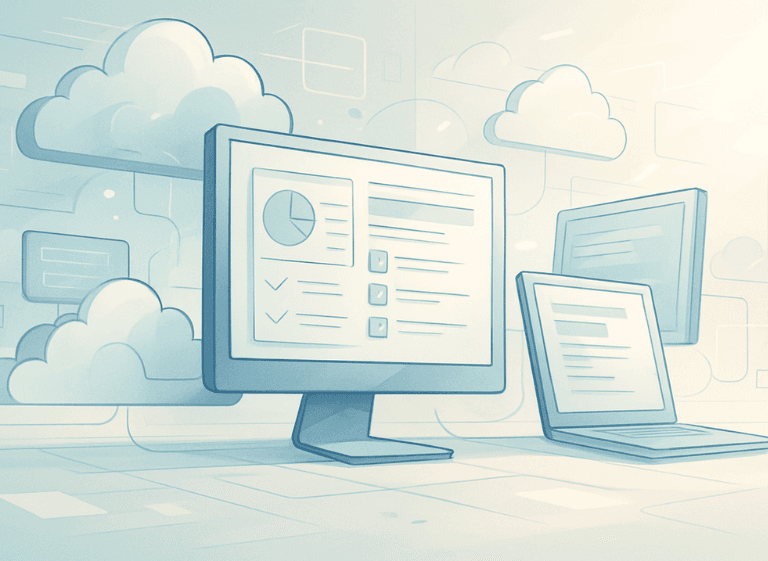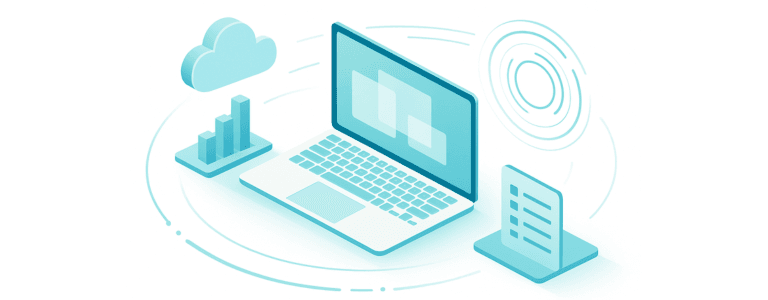Desktop development
DevOps practices
Security practices
Cross-platform development
Optimizing Enterprise Desktop Apps: Deployment Challenges & Solutions
Nadiia Sidenko
2025-07-11
Enterprise desktop applications remain critical infrastructure for most organizations, yet their deployment and update processes often consume disproportionate IT resources while creating security vulnerabilities and operational bottlenecks. Modern enterprises face mounting pressure to streamline these processes as distributed workforces demand faster, more reliable software delivery without compromising security or performance standards.

Why Enterprises Still Rely on Desktop Applications
Despite the cloud revolution, desktop applications continue to dominate enterprise environments due to fundamental advantages that web-based alternatives struggle to match.
Unmatched Performance & Speed
Desktop applications leverage local hardware resources directly, delivering computational performance that cloud-based alternatives cannot match. Key advantages include:
- Direct hardware access - Applications utilize full CPU, GPU, and memory resources without network overhead
- Millisecond response times - Critical for financial trading platforms and real-time data processing
- Local processing power - CAD programs and engineering software avoid network latency completely
- Zero bandwidth competition - Applications don't compete for internet resources during intensive operations
Organizations report productivity gains of 40-60% when migrating from cloud-based to optimized desktop applications for compute-intensive tasks.
Enhanced Security & Local Control
Enterprise security teams favor desktop applications for their ability to operate within controlled network environments:
- Air-gapped operation - Applications function without internet connectivity, eliminating remote attack vectors
- Local encryption - Data encrypted and processed entirely within controlled environments
- Granular access controls - Sophisticated permissions and audit trails without cloud dependencies
- Regulatory compliance - Easier to meet GDPR, HIPAA, and SOX requirements with local processing
Organizations in heavily regulated industries report 75% fewer security incidents when using properly configured desktop applications compared to cloud-based alternatives.
Rich UI/UX & Deeper System Integration
Desktop applications access native operating system features that web applications cannot reach. They integrate seamlessly with local file systems, hardware peripherals, and system notifications, enabling sophisticated user experiences that feel natural and responsive.
Offline Functionality & Data Resilience
Network connectivity remains unreliable in many enterprise scenarios. Desktop applications provide this reliability by storing data locally and synchronizing when connectivity allows. This capability becomes mission-critical for industries like construction, mining, or emergency services where reliable internet access is not guaranteed.
The Core Challenges of Enterprise Desktop Application Deployment and Updates
Enterprise desktop application deployment presents unique complexities that multiply across distributed organizations where consistency, security, and reliability become paramount concerns.
Inconsistent Updates Across Distributed Workforces
Modern enterprises face significant challenges maintaining consistent application versions across distributed teams:
- Version fragmentation - Different locations running incompatible application versions
- Network bandwidth limitations - Large updates overwhelming limited internet connectivity
- Time zone coordination - Scheduling updates across global teams without disrupting workflows
- Remote device management - Ensuring updates reach mobile workers and home offices
High Costs and Resource Drain
Manual deployment processes consume substantial IT resources that could be allocated to strategic initiatives. System administrators spend countless hours managing individual installations, troubleshooting compatibility issues, and coordinating update schedules across departments.
Organizations typically spend 15-20% of their IT budgets on application deployment and maintenance activities, with this percentage increasing significantly for organizations with complex multi-platform environments.
Security Vulnerabilities and Compliance Risks
Inconsistent update deployment creates security gaps that organizations struggle to manage effectively:
| Risk Category | Traditional Deployment | Modern CI/CD Deployment | Risk Reduction |
|---|---|---|---|
| Unpatched Vulnerabilities | 45–60 days average | 1–3 days average | 85% faster |
| Version Visibility | 60–70% devices tracked | 95–98% devices tracked | 40% improvement |
| Compliance Reporting | Manual, error-prone | Automated, auditable | 90% less effort |
| Incident Response Time | 4–8 hours average | 30–60 minutes average | 75% faster |
| Security Baseline Drift | Common occurrence | Prevented by automation | 95% reduction |
User Downtime and Productivity Loss
Traditional deployment methods often require significant user downtime. Applications must be closed, updated, and restarted, disrupting ongoing work and forcing users to schedule updates around their productivity cycles.
Complexity of Multi-Platform and Legacy Systems
Enterprise environments typically include diverse operating systems, hardware configurations, and legacy applications that complicate deployment strategies. Applications must function consistently across Windows, macOS, and Linux environments while maintaining compatibility with existing infrastructure components.

Key Strategies for Streamlining Desktop Application Deployment and Updates
Modern deployment strategies focus on automation, consistency, and reliability to address the challenges inherent in enterprise desktop application management.
Embracing Modern Deployment Tools and Platforms
Contemporary deployment platforms provide centralized management capabilities that eliminate many traditional deployment challenges:
| Tool | Best For | Key Features | Ideal Organization Size |
|---|---|---|---|
| Microsoft SCCM | Windows-dominant environments | Comprehensive Windows management | 500+ devices |
| Microsoft Intune | Cloud-native and BYOD | Cloud-based device management | 100+ devices |
| Jamf Pro | macOS environments | Apple ecosystem integration | 50+ Mac devices |
| Chocolatey | DevOps automation | Package management scripting | Any size |
| Ansible | Multi-platform automation | Infrastructure as Code | 100+ devices |
Implementing Robust Version Control and Build Automation (CI/CD)
CI/CD for desktop apps transforms application deployment from manual processes into automated, repeatable workflows. These systems automatically build, test, and deploy applications whenever code changes are committed to version control repositories.
To ensure seamless desktop app updates across platforms, Pinta WebWare implemented CI/CD automation for Notifix using Next.js, Firebase, and Chakra UI. The automated desktop deployment pipeline demonstrated significant improvements:
| Metric | Before CI/CD Implementation | After CI/CD Implementation | Improvement |
|---|---|---|---|
| Deployment Time | 4–6 hours manual process | 15–20 minutes automated | 85% reduction |
| Deployment Success Rate | 78% (frequent manual errors) | 98% (automated validation) | 26% improvement |
| Cross-Platform Consistency | 65% (platform-specific issues) | 95% (automated testing) | 46% improvement |
| Security Patch Deployment | 3–5 days average | Same day deployment | 80% faster |
| IT Resource Hours per Deployment | 12–15 hours | 2–3 hours | 83% reduction |
Leveraging Containerization and Virtualization
Containerization technologies like Docker enable consistent application deployment across diverse environments. Applications packaged in containers include all dependencies, libraries, and configuration files needed for execution, eliminating compatibility issues from different system configurations.
Adopting a Staged Rollout (Phased Deployment) Approach
Phased deployment strategies minimize risk by gradually introducing new application versions across the organization:
| Strategy | Description | Advantages | Disadvantages |
|---|---|---|---|
| Blue-Green | Two identical environments, instant switch | Zero downtime, instant rollback | Requires 2x infrastructure |
| Canary Release | Gradual rollout to small user percentage | Safe testing, real user feedback | Complex traffic routing |
| Rolling Update | Sequential replacement of instances | Minimal disruption, resource efficient | Slower rollback process |
| Feature Flags | Deploy code, enable features gradually | Separate deployment from release | Requires additional development |
Prioritizing Automated Testing and Quality Assurance
Comprehensive testing automation ensures application quality before deployment while reducing manual testing overhead. Unit testing, integration testing, and end-to-end testing run automatically before deployment, catching issues before they reach end users.
Implementing Robust Rollback and Recovery Mechanisms
Effective rollback mechanisms enable rapid recovery from failed deployments. These systems maintain previous application versions and can restore them quickly if issues are discovered, reducing deployment risks by providing reliable recovery options.
Considering Cloud-Native Features for Desktop Apps (Hybrid Approach)
Hybrid cloud deployment combines local application execution with cloud-based services. Applications run locally for performance and reliability while leveraging cloud services for updates, configuration management, and data synchronization.
Best Practices for Effective Enterprise Desktop App Management
Successful enterprise desktop application management requires comprehensive strategies that address technical, operational, and organizational challenges.
Develop a Clear Deployment Strategy and Policy
Comprehensive deployment policies establish consistent procedures across the organization:
| Factor | Traditional IT Deployment | Modern CI/CD Deployment |
|---|---|---|
| Time to Deploy | Weeks or months | Minutes to hours |
| Risk of Errors | High (manual processes) | Low (automated validation) |
| Update Consistency | Irregular, manual | Predictable, automated |
| Resource Requirements | High IT staff involvement | Minimal manual intervention |
| Rollback Capability | Complex, time-consuming | Automated, rapid |
Standardize Development and Deployment Environments
Environment standardization eliminates inconsistencies that cause deployment failures. Development, testing, and production environments should use identical configurations, dependencies, and infrastructure components.
Monitor Performance and User Feedback Post-Deployment
Continuous monitoring provides visibility into application performance and user experience after deployment. Performance metrics, error rates, and usage patterns identify issues that may require attention.
Partnering with an Experienced Custom Software Development Company
Custom software development partnerships provide access to specialized expertise and advanced capabilities. The definition of enterprise app development encompasses complex requirements that not all development teams can address effectively.
The Future of Enterprise Desktop Apps: Key Trends for 2025+
Enterprise desktop application development continues evolving with several key trends shaping the future. Cross-platform development frameworks like Electron, .NET MAUI, and Flutter Desktop are becoming standard, enabling single codebases to target multiple operating systems. AI and machine learning integration provides intelligent automation and predictive analytics, while hybrid cloud architectures balance local performance with cloud scalability. Green computing principles influence sustainable development practices, and modular architectures enable more efficient deployment and maintenance. These trends collectively point toward more efficient, intelligent, and sustainable desktop application ecosystems.

Conclusion
Enterprise desktop application deployment has evolved from manual, error-prone processes to sophisticated automated workflows that prioritize reliability, security, and efficiency. Organizations that embrace modern deployment strategies achieve significant improvements in deployment success rates, security posture, and operational efficiency.
The future lies in balancing the performance advantages of local execution with the management benefits of cloud-based deployment services. Success requires strategic planning, investment in modern tools and processes, and partnerships with experienced development teams. Organizations that discuss your project with our team can leverage specialized expertise to navigate the complexities of enterprise desktop application deployment while achieving their performance, security, and operational objectives.